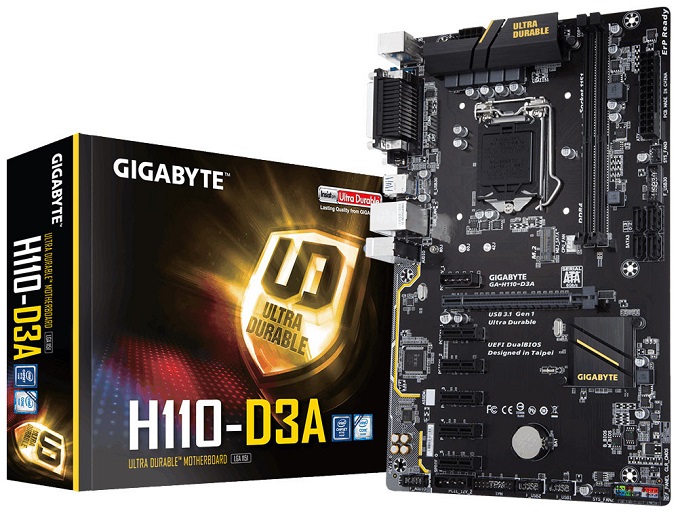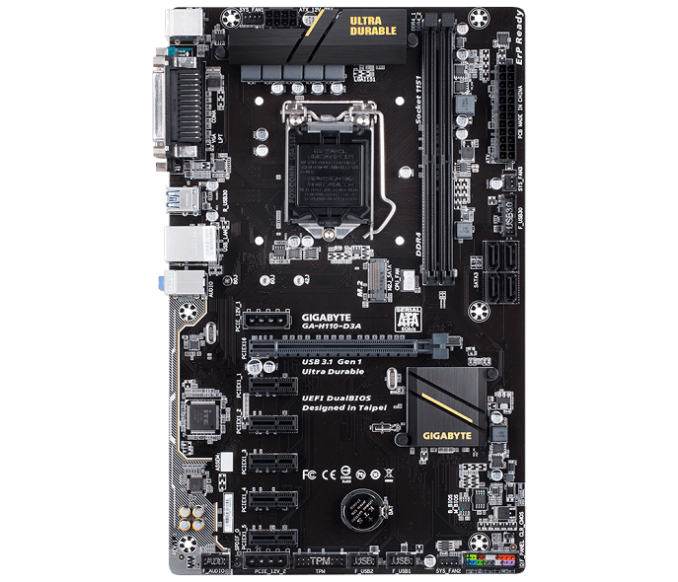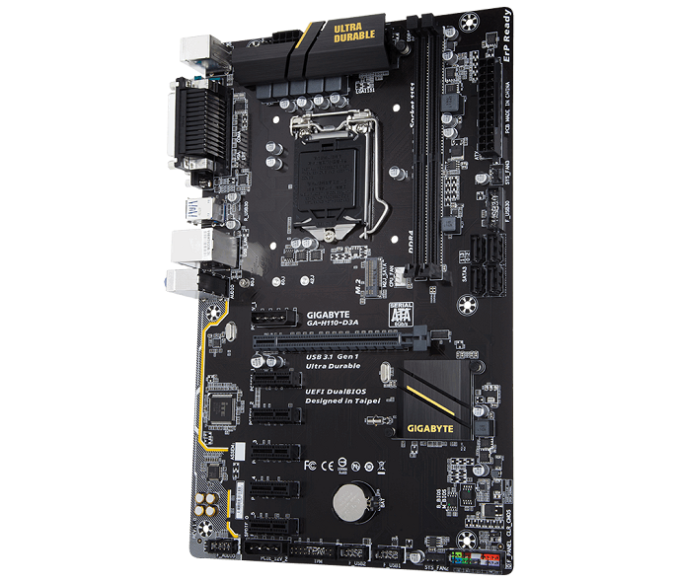Gigabyte Announces H110-D3A Motherboard for Mining Rigs: The Mining Cart Rolls on
by Joe Shields on July 18, 2017 10:00 AM EST- Posted in
- Motherboards
- Gigabyte
- Bitcoin
- Cryptocurrency
- H110
- Minig

GIGABYTE this week has taken the wraps off of a new motherboard built specifically for the again popular cryptocurrency mining crowd: the H110-D3A. Like other boards targeted at mining, there are a plethora of PCIe x1 slots. Having several PCIe x1 slots on mining motherboards make it more cost effective to simply add more video cards into a single system, rather than expanding to additional systems. Despite this being a mining focused board, some more common features found in mainstream consumers boards are here, such as a Realtek ALC887 audio codec, although others are left out as well in an effort to reduce board prices for this cost-conscious and investment-oriented market.
Based on Intel's H110 chipset, the H110-D3A has five PCIe x1 slots from the PCH and a PCIe x16 slot from the CPU, giving a total of six slots for GPU mining. This is compared to a typical consumer motherboard board with three or four PCIe slots, so it is easy to see the value proposition for miners. Due to the socket/chipset combination, processor support is for both 6th and 7th generation Intel CPUs, while memory support is listed at DDR4-2133/2400 and 32GB for the two DIMM slots. It is pretty sparse on extra features, as are most boards aimed at mining, but it still offers a full PCIe 3.0 x4 M.2 slot and four SATA 6 Gbps ports.
The board is built using GIGABYTE's “Ultra Durable” components, which GIGABYTE states are tested for extended operation. Power is fed to the board and CPU via the usual 24-Pin ATX and 8-Pin EPS sockets, which in turn is regulated by a 5-phase VRM setup. Two additional power headers, via 4-Pin Molex plugs, are located above the first PCIe (x16) slot and below the last (x1) slot to handle the additional power required for running several video cards through the multiple PCIe slots.
Connectivity on the rear panel is basic, but all the required elements are there. This consists of two PS/2 ports, one parallel port, one serial port, a VGA port, two USB 3.0 ports, two USB2 ports, a Realtek Gbe LAN RJ-45 port, and Realtek ALC887 based audio.
| GIGABYTE H110-D3A | |
| Warranty Period | 3 Years |
| Product Page | Link |
| Price | $89 |
| Size | ATX |
| CPU Interface | LGA1151 |
| Chipset | Intel H110 |
| Memory Slots (DDR4) | Two DDR4 Supporting 32GB Quad Channel Up to 2133/2400 MHz |
| Network Connectivity | Realtek GbE LAN chip |
| Onboard Audio | Realtek ALC887 |
| PCIe Slots for Graphics (from CPU) | 1 x PCIe 3.0 x16 |
| PCIe Slots for Other | 5 x PCIe 3.0 x1 |
| Onboard SATA | Four |
| Onboard SATA Express | None |
| Onboard M.2 | 1 x SATA |
| Onboard U.2 | None |
| USB 3.1 | 2 x Rear Panel |
| USB 3.0 | None |
| USB 2.0 | 2 x Rear Panel |
| Power Connectors | 1 x 24-pin ATX 1 x 8-pin CPU, 2 x 4-pin Molex |
| IO Panel | 1 x PS/2 Mouse port 1 x PS/2 Keyboard port 1 x parallel port 1 x serial port 1 x D-Sub port 2 x USB 3.1 Gen 1 ports 2 x USB 2.0/1.1 ports 1 x RJ-45 port 3 x audio jacks (Line In, Line Out, Mic In) |
| Form Factor/Size | ATX Form Factor; 30.5cm x 19.0cm |
Pricing is currently $89 at Newegg.com, though the board is not in stock at the time of writing. Compared to the Biostar TB250-BTC (see in the links below). the cost is a few dollars less with a similar number of PCIe slots available for mining duties. The competition seems to be heating up around the sub $100 segment for mining boards as more boards hit the market and board partners attempt to cash in on the mining craze.
Related Reading
Source: GIGABYTE












18 Comments
View All Comments
austinsguitar - Tuesday, July 18, 2017 - link
this whole mining thing is making me go **** crazy. as a consumer of electronics its awful, prices going up on litterally everything from ram to graphics cards all because some upper middle class junkies herd they could make money off this crap. IT'S TIME TO STOPPPJoeyJoJo123 - Tuesday, July 18, 2017 - link
Well, memory prices were bad even before the mining craze started. That's partially due to instability and insufficiency in supply in the DRAM market for a while now, and Toshiba's attempt at selling off their memory business isn't helping either.The GPUs are totally miners' fault though.
Right now's just a really bad time to be building PCs, moreso than it has been in a really long time. Memory's expensive. Intel X299 platform is kind of a mixed bag. AMD hasn't been very competitive for the past few years in the CPU space, up until the Ryzen launch, but there may be some teething issues with compatibility still. Nvidia and AMD GPU shelves are empty due to miners and stock issues still aren't resolved. AMD hasn't been very competitive in the high-end GPU market lately, and the coming Vega launch may not change much if it's just topping out at potentially GTX-1080-level performance.
sleepeeg3 - Wednesday, July 19, 2017 - link
So buy a card and start mining! It will pay for itself.extremepcs - Tuesday, July 18, 2017 - link
Why a parallel port?smilingcrow - Tuesday, July 18, 2017 - link
They are to interface with parallel universes.philehidiot - Tuesday, July 18, 2017 - link
Sadly, I work in a hospital and our equipment is so outdated we still print via a parallel port. That we even print clinical information these days is ridiculous but we do it using parallel....Drumsticks - Tuesday, July 18, 2017 - link
Man, if I was one of the HW companies right now I'd be drawing down production of these mining parts, or at least watching them closely. Mining is still profitable for now, but given that we might be drawing closer to the floor dropping out, they might not want to be left around with mining specific stock.MrSpadge - Tuesday, July 18, 2017 - link
Since the recent Ethereum difficulty increase and price drop the German Ebay is already being flooded with Polaris cards, as they'd only earn ~10€/month now. People selling now want to cash in on the still-high price, rather than wait for the next WhateverCoin made for GPUs.KaarlisK - Tuesday, July 18, 2017 - link
Something I do not get: if the ports are not open-ended, how do you plug in a x16 card?Or do you use an expander?
MrSpadge - Tuesday, July 18, 2017 - link
You need expanders anyway, because single slot cooling is far too wimpy for these tasks. The higher rpm fans consume more power (few W, but it adds up) and the heated cards consume more power (can be double digit Ws, depending on the model, voltage etc.) and degrade faster.